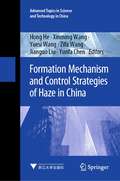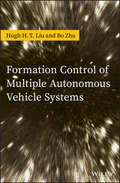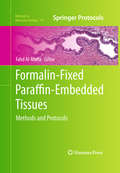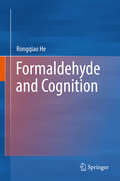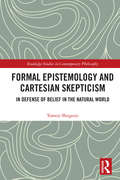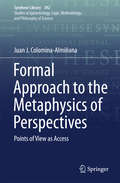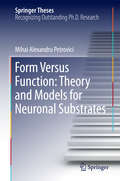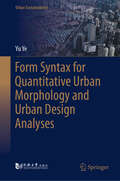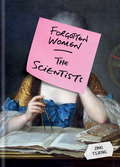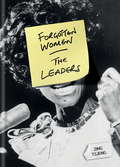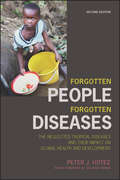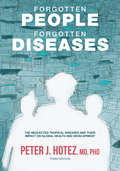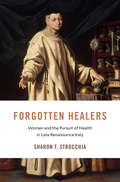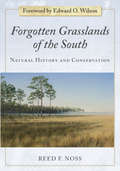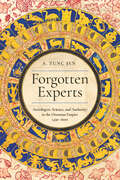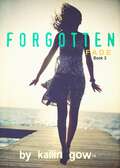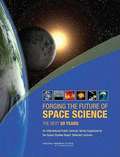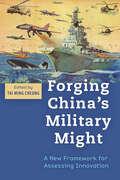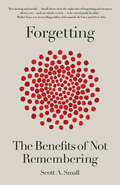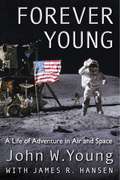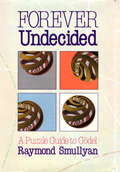- Table View
- List View
Formation Mechanism and Control Strategies of Haze in China (Advanced Topics in Science and Technology in China #66)
by Jianguo Liu Hong He Xinming Wang Yuesi Wang Zifa Wang Yunfa ChenThis book summarizes the new major research findings about formation mechanism and control strategies of haze in China, including basic theories, key technologies, equipment and platforms and the applications and implementations of control technologies, in implementing the Strategic Priority Research Program (Class B) of Chinese Academy of Sciences. Different types of air pollution processes experienced by the developed countries in different stages are out-breaking simultaneously in China in the recent years and resulting a new type of “haze chemistry smog” pollution, which is different from the “London smog” and the “Los Angeles photochemical smog”. This book provides a useful reference for related researchers, engineers and policy-makers engaged in atmospheric pollution research, prevention and control in China and other countries.
Formation Control of Multiple Autonomous Vehicle Systems
by Hugh H. Liu Bo ZhuThis text explores formation control of vehicle systems and introduces three representative systems: space systems, aerial systems and robotic systems Formation Control of Multiple Autonomous Vehicle Systems offers a review of the core concepts of dynamics and control and examines the dynamics and control aspects of formation control in order to study a wide spectrum of dynamic vehicle systems such as spacecraft, unmanned aerial vehicles and robots. The text puts the focus on formation control that enables and stabilizes formation configuration, as well as formation reconfiguration of these vehicle systems. The authors develop a uniform paradigm of describing vehicle systems’ dynamic behaviour that addresses both individual vehicle’s motion and overall group’s movement, as well as interactions between vehicles. The authors explain how the design of proper control techniques regulate the formation motion of these vehicles and the development of a system level decision-making strategy that increases the level of autonomy for the entire group of vehicles to carry out their missions. The text is filled with illustrative case studies in the domains of space, aerial and robotics. • Contains uniform coverage of "formation" dynamic systems development • Presents representative case studies in selected applications in the space, aerial and robotic systems domains • Introduces an experimental platform of using laboratory three-degree-of-freedom helicopters with step-by-step instructions as an example • Provides open source example models and simulation codes • Includes notes and further readings that offer details on relevant research topics, recent progress and further developments in the field Written for researchers and academics in robotics and unmanned systems looking at motion synchronization and formation problems, Formation Control of Multiple Autonomous Vehicle Systems is a vital resource that explores the motion synchronization and formation control of vehicle systems as represented by three representative systems: space systems, aerial systems and robotic systems.
Formalin-Fixed Paraffin-Embedded Tissues
by Fahd Al-MullaPresenting an area of research that intersects with and integrates diverse disciplines, including genomics, epigenetics, proteomics, and cellular biology, among others, Formalin-Fixed Paraffin-Embedded Tissues: Methods and Protocols collects contributions from expert researchers in order to provide practical guidelines to this complex study. Compiled in order to provide researchers with up-to-date methodological information pertaining to the utilization of genomic, transcriptomic, and proteomic data in diagnosis, prognosis, and tailored therapy, the ultimate aim of this volume is to decipher diseases at a molecular level. Divided into multiple convenient chapters, this detailed book covers various techniques to construct and utilize tissue arrays, it also provides detailed protocols in immunohistochemistry, immunofluorescence, fluorescent and chromogenic in situ hybridization, and ultimately introduces protocols for FFPET microdissection and nucleic acids extraction for their utilization in advanced techniques such as microarray CGH, DNA methylation and pyrosequencing. The volume also discusses FFPET research from an ethical standpoint and concludes with a chapter on novel tissue fixative. Written in the highly successful Methods in Molecular BiologyTM series format, chapters contain introductions to their respective topics, lists of the necessary materials and reagents, step-by-step, readily reproducible laboratory protocols, and notes on troubleshooting and avoiding known pitfalls. Authoritative and accessible, Formalin-Fixed Paraffin-Embedded Tissues: Methods and Protocols serves as a practical guide for scientists of all backgrounds and aims to convey the appropriate sense of fascination associated with this vital field of research.
Formaldehyde and Cognition
by Rongqiao HeThis book introduces important, new knowledge regarding formaldehyde, especially endogenous formaldehyde, revealing its many key roles in the human body. It reviews the relationship between endogenous formaldehyde and cognition as well as age-related cognitive impairment, by discussing different aspects such as formaldehyde metabolism, its function in the brain, links with epigenetics and neurophysiology, and epidemiological and clinical investigations. The author also provides suggestions on how to prevent cognitive impairment resulting from excess endogenous formaldehyde. This book appeals to all readers who are interested in cognitive science and toxicology.
Formal Epistemology and Cartesian Skepticism: In Defense of Belief in the Natural World (Routledge Studies in Contemporary Philosophy)
by Tomoji ShogenjiThis book develops new techniques in formal epistemology and applies them to the challenge of Cartesian skepticism. It introduces two formats of epistemic evaluation that should be of interest to epistemologists and philosophers of science: the dual-component format, which evaluates a statement on the basis of its safety and informativeness, and the relative-divergence format, which evaluates a probabilistic model on the basis of its complexity and goodness of fit with data. Tomoji Shogenji shows that the former lends support to Cartesian skepticism, but the latter allows us to defeat Cartesian skepticism. Along the way, Shogenji addresses a number of related issues in epistemology and philosophy of science, including epistemic circularity, epistemic closure, and inductive skepticism.
Formal Approach to the Metaphysics of Perspectives: Points of View as Access (Synthese Library #392)
by Juan J. Colomina-AlmiñanaThis book offers a metaphysical development of the notion of perspective. By explaining the functional nature of point of view, and by providing a concrete definition of point of view as a window through which to see the world, it offers a scientific realist theory that explains that points of view are real structures that ground properties and objects as well as perspectives. The notion of point of view has been of key importance in the history of philosophy, and different philosophical schools have used this notion to conduct analyses from the external reality to the inner phenomenal status, or even to construct an entire philosophical system. However, there has been a lack of systematic analysis of what a point of view is and what its structure is; this book fills the gap in the literature and makes the transition between semantics and epistemology, and the philosophy of science.
Form Versus Function: Theory and Models for Neuronal Substrates
by Mihai Alexandru PetroviciThis thesis addresses one of the most fundamental challenges for modern science: how can the brain as a network of neurons process information, how can it create and store internal models of our world, and how can it infer conclusions from ambiguous data? The author addresses these questions with the rigorous language of mathematics and theoretical physics, an approach that requires a high degree of abstraction to transfer results of wet lab biology to formal models. The thesis starts with an in-depth description of the state-of-the-art in theoretical neuroscience, which it subsequently uses as a basis to develop several new and original ideas. Throughout the text, the author connects the form and function of neuronal networks. This is done in order to achieve functional performance of biological brains by transferring their form to synthetic electronics substrates, an approach referred to as neuromorphic computing. The obvious aspect that this transfer can never be perfect but necessarily leads to performance differences is substantiated and explored in detail. The author also introduces a novel interpretation of the firing activity of neurons. He proposes a probabilistic interpretation of this activity and shows by means of formal derivations that stochastic neurons can sample from internally stored probability distributions. This is corroborated by the author's recent findings, which confirm that biological features like the high conductance state of networks enable this mechanism. The author goes on to show that neural sampling can be implemented on synthetic neuromorphic circuits, paving the way for future applications in machine learning and cognitive computing, for example as energy-efficient implementations of deep learning networks. The thesis offers an essential resource for newcomers to the field and an inspiration for scientists working in theoretical neuroscience and the future of computing.
Form Syntax for Quantitative Urban Morphology and Urban Design Analyses (Urban Sustainability)
by Yu YeThis book sets out to develop a quantitative-based analysis, Form Syntax, which is able to identify various prototypes of urban forms and their degrees of urbanity, thereby enhancing urban design practices. Form Syntax is a combination of emerging quantitative analysis tools with qualitative urban morphology tradition. It integrates a set of spatial analysis tools including Space Syntax, Spacematrix, and Mixed-use index (MXI) through GIS to measure the morphological features of streets, buildings and blocks, and functions. Furthermore, the Form Syntax assists in comprehending the intrinsic, evolving logic of urban form. Based on the findings of urban morphology, the Urban Form Index could function as an analytical instrument in numerous phases of the urban design process, thereby promoting urban vitality. Moreover, morphology-led understandings of urban design theory can inform urban design practices. This study endeavors to introduce quantitative thinking into urban morphology and urban design, with the objective of developing a lively built environment and pursuing more vibrant place-making.
Forgotten Women: The Scientists (Forgotten Women)
by Zing Tsjeng'To say this series is "empowering" doesn't do it justice. Buy a copy for your daughters, sisters, mums, aunts and nieces - just make sure you buy a copy for your sons, brothers, dads, uncles and nephews, too.' - indy100'Here's to no more forgotten women.' Evening StandardThe women who shaped and were erased from our history.The Forgotten Women series will uncover the lost histories of the influential women who have refused over hundreds of years to accept the hand they've been dealt and, as a result, have formed, shaped and changed the course of our futures. The Scientists celebrates 48* unsung scientific heroines whose hugely important, yet broadly unacknowledged or incorrectly attributed, discoveries have transformed our understanding of the scientific world. Mary Anning, the amateur paleontologist whose fossil findings changed scientific thinking about prehistoric life Emmy Noether, dubbed "The Mighty Mathematician You've Never Heard Of"Ynés Mexía, the Mexican-American botanist who discovered over 500 new plant species Wangari Maathai, who started an environmental and ecological revolution in KenyaMargaret Sanger, the maverick nurse who paved the way for the legalization of contraceptionChapters including Earth & Universe; Biology & Natural Sciences; Medicine & Psychology; Physics & Chemistry; Mathematics and Technology & Inventions profile the female scientists who have defied the odds, and the opposition, to change the world around us.*The number of Nobel-prize-winning women.
Forgotten Women: The Scientists
by Zing Tsjeng'To say this series is "empowering" doesn't do it justice. Buy a copy for your daughters, sisters, mums, aunts and nieces - just make sure you buy a copy for your sons, brothers, dads, uncles and nephews, too.' - indy100'Here's to no more forgotten women.' Evening StandardThe women who shaped and were erased from our history.The Forgotten Women series will uncover the lost histories of the influential women who have refused over hundreds of years to accept the hand they've been dealt and, as a result, have formed, shaped and changed the course of our futures. The Scientists celebrates 48* unsung scientific heroines whose hugely important, yet broadly unacknowledged or incorrectly attributed, discoveries have transformed our understanding of the scientific world. Mary Anning, the amateur paleontologist whose fossil findings changed scientific thinking about prehistoric life Emmy Noether, dubbed "The Mighty Mathematician You've Never Heard Of"Ynés Mexía, the Mexican-American botanist who discovered over 500 new plant species Wangari Maathai, who started an environmental and ecological revolution in KenyaMargaret Sanger, the maverick nurse who paved the way for the legalization of contraceptionChapters including Earth & Universe; Biology & Natural Sciences; Medicine & Psychology; Physics & Chemistry; Mathematics and Technology & Inventions profile the female scientists who have defied the odds, and the opposition, to change the world around us.*The number of Nobel-prize-winning women.
Forgotten Women: The Leaders (Forgotten Women)
by Zing TsjengSelected for the Evening Standard present gift guide of the year'To say this series is "empowering" doesn't do it justice. Buy a copy for your daughters, sisters, mums, aunts and nieces - just make sure you buy a copy for your sons, brothers, dads, uncles and nephews, too.' - indy100'Here's to no more forgotten women.' Evening StandardThe women who shaped and were erased from our history.The Forgotten Women series will uncover the lost histories of the influential women who have refused over hundreds of years to accept the hand they've been dealt and, as a result, have formed, shaped and changed the course of our futures. The Leaders weaves together 48* unforgettable portraits of the true pioneers and leaders who made huge yet unacknowledged contributions to history, including:Grace O'Malley, the 16th century Irish pirate queenSylvia Rivera, who spearheaded the modern transgender rights movementAgent 355, the unknown rebel spy who played a pivotal role in the American RevolutionNoor Inayat Khan, who went undercover to spy for the French Resistance and became Nazi enemy no. 1Amina of Zazzau, the formidable ancient Muslim warrior queen of Northern NigeriaChapters including Rebels; Warriors; Rulers; Activists and Reformers shine a spotlight on the rebellious women who defied the odds, and the opposition, to change the world around them. *The number of Nobel-prize-winning women.
Forgotten Women: The Leaders (Forgotten Women Ser.)
by Zing Tsjeng'To say this series is "empowering" doesn't do it justice. Buy a copy for your daughters, sisters, mums, aunts and nieces - just make sure you buy a copy for your sons, brothers, dads, uncles and nephews, too.' - indy100The women who shaped and were erased from our history.The Forgotten Women series will uncover the lost histories of the influential women who have refused over hundreds of years to accept the hand they've been dealt and, as a result, have formed, shaped and changed the course of our futures. The Leaders weaves together 48* unforgettable portraits of the true pioneers and leaders who made huge yet unacknowledged contributions to history, including:Grace O'Malley, the 16th century Irish pirate queenSylvia Rivera, who spearheaded the modern transgender rights movementAgent 355, the unknown rebel spy who played a pivotal role in the American RevolutionNoor Inayat Khan, who went undercover to spy for the French Resistance and became Nazi enemy no. 1Amina of Zazzau, the formidable ancient Muslim warrior queen of Northern NigeriaChapters including Rebels; Warriors; Rulers; Activists and Reformers shine a spotlight on the rebellious women who defied the odds, and the opposition, to change the world around them. *The number of Nobel-prize-winning women.
Forgotten People, Forgotten Diseases: The Neglected Tropical Diseases and their Impact on Global Health and Development (ASM Books)
by Peter J. HotezForgotten People, Forgotten Diseases Second Edition The neglected tropical diseases (NTDs) are the most common infections of the world's poor, but few people know about these diseases and why they are so important. This second edition of Forgotten People, Forgotten Diseases provides an overview of the NTDs and how they devastate the poor, essentially trapping them in a vicious cycle of extreme poverty by preventing them from working or attaining their full intellectual and cognitive development. Author Peter J. Hotez highlights a new opportunity to control and perhaps eliminate these ancient scourges, through alliances between nongovernmental development organizations and private-public partnerships to create a successful environment for mass drug administration and product development activities. Forgotten People, Forgotten Diseases also Addresses the myriad changes that have occurred in the field since the previous edition. Describes how NTDs have affected impoverished populations for centuries, changing world history. Considers the future impact of alliances between nongovernmental development organizations and private-public partnerships. Forgotten People, Forgotten Diseases is an essential resource for anyone seeking a roadmap to coordinate global advocacy and mobilization of resources to combat NTDs.
Forgotten People, Forgotten Diseases: The Neglected Tropical Diseases and Their Impact on Global Health and Development (ASM Books)
by Peter J. HotezThe neglected tropical diseases (NTDs) are among the most common infections of the world’s poorest people and have profound ramifications on affected populations, including physical, mental, social, and economic. This third edition of Forgotten People, Forgotten Diseases coincides with the third decade of the NTDs movement, which has given access to essential NTD preventative treatments and medications to more than 1 billion people. Professor Peter Hotez, MD, PhD, one of the founders of the NTD movement, discusses how the NTD space evolved and control was implemented against these ancient scourges, through alliances between nongovernmental development organizations and private-public partnerships. Forgotten People, Forgotten Diseases also Reports on the health and economic effects of the NTDs, and the challenges of measuring diseases that do not always kill, but adversely affect productivity, child development, pregnancy outcome, and economic development. Lays a roadmap for continued control of existing and newly identified NTDs and spotlights potential opportunities for reducing global poverty and “repairing the world.” Describes a global initiative to provide annual mass drug administration for more than one billion people affected by NTDs. Highlights the role of innovation and product development partnerships for new treatments and vaccines. Explains how science and vaccine diplomacy ensure that a new generation of biotechnologies reaches the world’s poorest people. Forgotten People, Forgotten Diseases remains an essential resource for anyone seeking insight into global advocacy coordination and mobilization of resources to combat NTDs and continues to tell the story of the world’s people who live in extreme poverty and what it means for them to live with these devastating diseases. “Like Dr. Hotez, I have struggled with how to best get the word out about our need to address NTDs and their link to poverty. Now he has provided us all with a remarkable tool, a book for people without an extensive scientific or medical background. Forgotten People, Forgotten Diseases is an excellent ‘one-stop’ primer about NTDs.”—Soledad O’Brien, Host, Matter of Fact with Soledad O’Brien
Forgotten Healers: Women and the Pursuit of Health in Late Renaissance Italy (I Tatti studies in Italian Renaissance history)
by Sharon T. StrocchiaIn Renaissance Italy women from all walks of life played a central role in health care and the early development of medical science. Observing that the frontlines of care are often found in the household and other spaces thought of as female, Sharon Strocchia encourages us to rethink women’s place in the history of medicine.
Forgotten Grasslands of the South: Natural History and Conservation
by Reed F NossForgotten Grasslands of the South is the study of one of the biologically richest and most endangered ecosystems in North America. In a seamless blend of science and personal observation, renowned ecologist Reed Noss explains the natural history of southern grasslands, their origin and history, and the physical determinants of grassland distribution, including ecology, soils, landform, and hydrology. In addition to offering fascinating new information about these little-studied ecosystems, Noss demonstrates how natural history is central to the practice of conservation. Although theory and experimentation have recently dominated the field of ecology, ecologists are coming to realize how these distinct approaches are not divergent but complementary, and that pursuing them together can bring greater knowledge and understanding of how the natural world works and how we can best conserve it. This long-awaited work sets a new standard for scientific literature and is essential reading for those who study and work to conserve the grasslands of the South as well as for everyone who is fascinated by the natural world.
Forgotten Experts: Astrologers, Science, and Authority in the Ottoman Empire, 1450–1600 (Stanford Ottoman World Series: Critical Studies in Empire, Nature, and Knowledge)
by A. Tunç ŞenForgotten Experts offers a history of Ottoman court astrologers and traces their shifting authority and prestige over the long sixteenth century. These individuals served the Ottoman court with their expertise in mathematical, astronomical, and astrological sciences, distinguishing themselves from other occult practitioners and esoteric specialists. While both prophecy and prognostication are attempts to map the terrain of the future, the astrologers' work did not claim spiritual weight as a prophecy but relied instead on methods of prediction developed from data and patterns elaborated through technical and scientific writings. Drawing on extensive manuscript and archival records written in Ottoman Turkish, Persian, and Arabic, A. Tunç Şen writes a history of science, state formation, and bureaucracy within the overarching tale of Ottoman imperial formation and protocols. He invites readers to follow Ottoman court astrologers' fluctuating careers as practitioners of a contentious science and shows how this class of learned individuals constructed its scientific authority despite numerous cultural, societal, and epistemic challenges. In understanding the expertise of court astrologers, we gain insight into the intricate social relations established and maintained between the men of knowledge and the men of rule, between expertise and statecraft, in the early modern Ottoman imperial context.
Forgotten (FADE Series #3)
by Kailin GowWinner of the IBPA Benjamin Franklin Silver Award! PRAISE FOR FADE: "Kailin Gow does her readers justice with this thrilling and mind boggling series. Fade introduces readers to a concept that is out of this world." - Woven Myst Young Adult Magazine DESCRIPTION for FORGOTTEN (FADE BOOK 3): A love that can never be forgotten... The truth about Celestra Caine comes back in the most shocking way. Everyone knew Celestra Caine was dangerous, but they didn't know she was THAT dangerous... As Celestra's memories begin returning to her after being Faded, and her identity is revealed, she learns the fate of the world really is in her hands, and that she, the mysterious and sexy fader Jack, and her handsome ex-boyfriend Gray are more connected to each other than she ever imagined. In this dystopian ya thriller, where nothing is what it seems, sometimes love can be strong enough to withstand time and space and never be forgotten. Kailin Gow's FADE Series(TM) FADE Falling (FADE #2) Forgotten (FADE #3) Fever (FADE #4)
Forging the Future of Space Science: The Next 50 Years
by National Research Council of the National AcademiesFrom September 2007 to June 2008 the Space Studies Board conducted an international public seminar series, with each monthly talk highlighting a different topic in space and Earth science. The principal lectures from the series are compiled in Forging the Future of Space Science. The topics of these events covered the full spectrum of space and Earth science research, from global climate change, to the cosmic origins of life, to the exploration of the Moon and Mars, to the scientific research required to support human spaceflight. The prevailing messages throughout the seminar series as demonstrated by the lectures in this book are how much we have accomplished over the past 50 years, how profound are our discoveries, how much contributions from the space program affect our daily lives, and yet how much remains to be done. The age of discovery in space and Earth science is just beginning. Opportunities abound that will forever alter our destiny.
Forging China's Military Might: A New Framework for Assessing Innovation
by Tai Ming Cheung“His collection of nine essays offers a comprehensive and insightful assessment of the Chinese defense science and technology (S&T).” —Pacific AffairsAmong the most important issues in international security today are the nature and the global implications of China’s emergence as a world-class defense technology power. Since the beginning of the twenty-first century, the Chinese defense industry has reinvented itself by emphasizing technological innovation and technology. This reinvention and its potential effects, both positive and negative, are attracting global scrutiny. Drawing insights from a range of disciplines, including history, social science, business, and strategic studies, Tai Ming Cheung and the contributors to Forging China’s Military Might develop an analytical framework to evaluate the nature, dimensions, and spectrum of Chinese innovation in the military and broader defense spheres.Forging China’s Military Might provides an overview of the current state of the Chinese defense industry and then focuses on subjects critical to understanding short- and long-term developments, including the relationship among defense contractors, regulators, and end-users; civil-military integration; China’s defense innovation system; and China’s place in the global defense economy. Case studies look in detail at the Chinese space and missile industry.“Constitutes high-quality, cutting-edge research on China’s defense industries. It should enjoy broad appeal—among academics, policy makers, security analysts, and business people in countries around the world.” —Andrew Scobell, RAND Corporation“Forging China’s Military Might belongs in any political science shelf interested in China’s issues and international security and considers the nature of China’s emergence as a world power.” —Midwest Book Review
Forgetting: The Benefits of Not Remembering
by Scott A. Small&“Fascinating and useful . . . The distinguished memory researcher Scott A. Small explains why forgetfulness is not only normal but also beneficial.&”—Walter Isaacson, bestselling author of Leonardo da Vinci and Steve JobsWho wouldn&’t want a better memory? Dr. Scott Small has dedicated his career to understanding why memory forsakes us. As director of the Alzheimer&’s Disease Research Center at Columbia University, he focuses largely on patients who experience pathological forgetting, and it is in contrast to their suffering that normal forgetting, which we experience every day, appears in sharp relief. Until recently, most everyone—memory scientists included—believed that forgetting served no purpose. But new research in psychology, neurobiology, medicine, and computer science tells a different story. Forgetting is not a failure of our minds. It&’s not even a benign glitch. It is, in fact, good for us—and, alongside memory, it is a required function for our minds to work best. Forgetting benefits our cognitive and creative abilities, emotional well-being, and even our personal and societal health. As frustrating as a typical lapse can be, it&’s precisely what opens up our minds to making better decisions, experiencing joy and relationships, and flourishing artistically. From studies of bonobos in the wild to visits with the iconic painter Jasper Johns and the renowned decision-making expert Daniel Kahneman, Small looks across disciplines to put new scientific findings into illuminating context while also revealing groundbreaking developments about Alzheimer&’s disease. The next time you forget where you left your keys, remember that a little forgetting does a lot of good.
Forged: An Altered Series Prequel (Altered)
by Jennifer RushBefore Anna and Sam, there was Dani and Sam.There's one rule that all Branch operatives must live by: No attachments. When Dani O'Brien entered the Branch, she planned to trade her freedom so that her family could have a better life. But joining up with the mysterious organization is more than she bargained for. Branch head Connor watches over her closely--too closely. The training is brutal, the experiments are secret, and the missions promise to be anything but ordinary. The only thing getting Dani through each day is the hope that she'll run into Sam--a young man, about her age, who wears the world on his shoulders.Find out how it all began in this short-story prequel to Jennifer Rush's thrilling and suspenseful Altered series.
Forever Young: A Life of Adventure in Air and Space
by John W YoungHe walked on the Moon. He flew six space missions in three different programs--more than any other human. He served with NASA for more than four decades. His peers called him the "astronaut's astronaut."Enthusiasts of space exploration have long waited for John Young to tell the story of his two Gemini flights, his two Apollo missions, the first-ever Space Shuttle flight, and the first Spacelab mission. Forever Young delivers all that and more: Young's personal journey from engineering graduate to fighter pilot, to test pilot, to astronaut, to high NASA official, to clear-headed predictor of the fate of Planet Earth.Young, with the assistance of internationally distinguished aerospace historian James Hansen, recounts the great episodes of his amazing flying career in fascinating detail and with wry humor. He portrays astronauts as ordinary human beings and NASA as an institution with the same ups and downs as other major bureaucracies. He frankly discusses the risks of space travel, including what went wrong with the Challenger and Columbia shuttles. Forever Young is one of the last memoirs produced by an early American astronaut. It is the first memoir written by a chief of the NASA astronaut corps. Young's experiences and candor make this book indispensable to everyone interested in the U.S. space program.
Forever Undecided
by Raymond M. SmullyanForever Undecided is the most challenging yet of Raymond Smullyan's puzzle collections. It is, at the same time, an introduction--ingenious, instructive, entertaining--to Gödel's famous theorems. With all the wit and charm that have delighted readers of his previous books, Smullyan transports us once again to that magical island where knights always tell the truth and knaves always lie. Here we meet a new and amazing array of characters, visitors to the island, seeking to determine the natives' identities. Among them: the census-taker McGregor; a philosophical-logician in search of his flighty bird-wife, Oona; and a regiment of Reasoners (timid ones, normal ones, conceited, modest, and peculiar ones) armed with the rules of propositional logic (if X is true, then so is Y). By following the Reasoners through brain-tingling exercises and adventures--including journeys into the "other possible worlds" of Kripke semantics--even the most illogical of us come to understand Gödel's two great theorems on incompleteness and undecidability, some of their philosophical and mathematical implications, and why we, like Gödel himself, must remain Forever Undecided!
Forever Ours: Real Stories of Immortality and Living from a Forensic Pathologist
by Janis Amatuzio[From the Book Jacket] As a physician, forensic pathologist, and coroner for several Minnesota counties, I have had the extraordinary privilege of caring for families and their loved ones when death comes suddenly, unexpectedly, or traumatically. My job is to speak for the dead, to solve the mystery of "What happened?" However, I have occasionally been faced with mysteries I cannot solve or explain. These experiences always baffle me, partly because as a scientist I seek to reach a reasonable degree of medical certainty, a rational explanation. But I have come to realize that for some experiences there is no explanation, just a deep knowing that I have encountered the Divine. - JANIS AMATUZIO, MD
